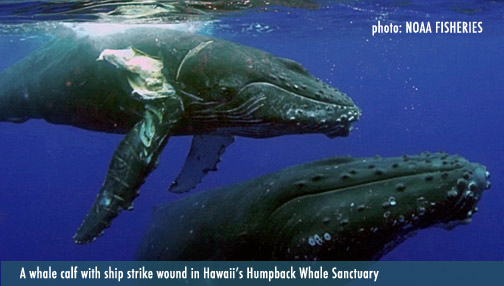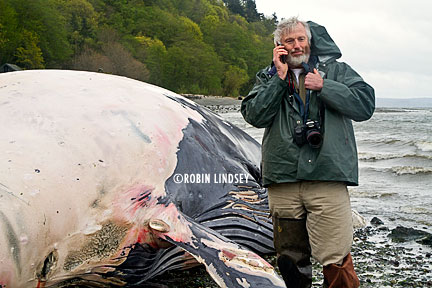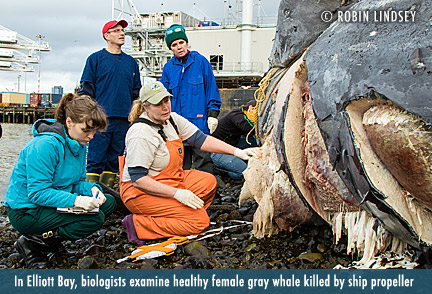SHIP STRIKES AN INCREASING THREAT TO LARGE WHALES
 Along the Pacific coast, magnificent whales migrate between nutrient-rich summer and fall feeding grounds in Alaska and warm water winter nurseries in Mexico and Hawaii. When newborn calves are strong enough, adult females take them on the long and perilous journey back north.
Along the Pacific coast, magnificent whales migrate between nutrient-rich summer and fall feeding grounds in Alaska and warm water winter nurseries in Mexico and Hawaii. When newborn calves are strong enough, adult females take them on the long and perilous journey back north.
Unfortunately, these corridors and harbors are busy with thousands of giant container ships. They move through krill feeding grounds where whales, an estimated19,000 gray whales (in addition to blues and humpbacks) forage near the surface during their migration - easy victims for ship strikes. The Channel Islands National Marine Sanctuary is working to reduce speed of ships in the Santa Barbara Channel, where five blue whales were struck and killed by ships in 2007. The challenge is to find a balance to keep animals safe and shipping companies agreeable.
In Washington, several endangered fin whales, an endangered species, have stranded recently, victims of ship strike. They are susceptible to mortal wounds because of their size, second largest whale in the world, and their tendency to feed near the water’s surface. Since 2002, there have been 10 stranded fin whales in Washington waters, 8 of which had evidence of vessel collisions.
Large baleen whales are vulnerable to ship strikes as they travel in waters along our Pacific coast, particularly in busy shipping lanes such as Los Angeles and Long Beach, California. Blue whales, the largest of all cetaceans and listed as endangered, are in peril of deadly collisions as they forage in these congested waters.
 Baleen whale mortality rates have been on the rise in recent years with increased annual shipping traffic. In 2009, California passed legislation requiring vessels traveling close to shore to burn cleaner fuels; this prompted many ships to change routes through whale feeding grounds. Large whales seem to show no fear of massive ships and the consequences are deadly.
Baleen whale mortality rates have been on the rise in recent years with increased annual shipping traffic. In 2009, California passed legislation requiring vessels traveling close to shore to burn cleaner fuels; this prompted many ships to change routes through whale feeding grounds. Large whales seem to show no fear of massive ships and the consequences are deadly.
Marine mammal research biologists, such as Cascadia Research's John Calambokidis (at right with ship strike fin whale), have been studying the impact of vessel collisions on whale populations in California and the Pacific Northwest and the behavior of whales when ships are in the area. These studies advocate for regulation changes to shipping lanes, such as reduced vessel speed and alternate routes.
Along the U.S. eastern seaboard, ship strikes account for 90% of all known deaths to endangered right whales, who migrate from Canada's Bay of Fundy feeding grounds to give birth off Florida. Stringent rules are now in effect for ships in right whale zones - 10 knot speed limit.
Responses to large whale strandings by members of NOAA’s West Coast Marine Mammal Stranding Network are in large part funded by the John H. Prescott Fund. This funding is reduced each year in the Federal budget. Contact your senator or state representative, asking that this critical funding be restored.
 Along the Pacific coast, magnificent whales migrate between nutrient-rich summer and fall feeding grounds in Alaska and warm water winter nurseries in Mexico and Hawaii. When newborn calves are strong enough, adult females take them on the long and perilous journey back north.
Along the Pacific coast, magnificent whales migrate between nutrient-rich summer and fall feeding grounds in Alaska and warm water winter nurseries in Mexico and Hawaii. When newborn calves are strong enough, adult females take them on the long and perilous journey back north. Unfortunately, these corridors and harbors are busy with thousands of giant container ships. They move through krill feeding grounds where whales, an estimated19,000 gray whales (in addition to blues and humpbacks) forage near the surface during their migration - easy victims for ship strikes. The Channel Islands National Marine Sanctuary is working to reduce speed of ships in the Santa Barbara Channel, where five blue whales were struck and killed by ships in 2007. The challenge is to find a balance to keep animals safe and shipping companies agreeable.
In Washington, several endangered fin whales, an endangered species, have stranded recently, victims of ship strike. They are susceptible to mortal wounds because of their size, second largest whale in the world, and their tendency to feed near the water’s surface. Since 2002, there have been 10 stranded fin whales in Washington waters, 8 of which had evidence of vessel collisions.
Large baleen whales are vulnerable to ship strikes as they travel in waters along our Pacific coast, particularly in busy shipping lanes such as Los Angeles and Long Beach, California. Blue whales, the largest of all cetaceans and listed as endangered, are in peril of deadly collisions as they forage in these congested waters.


Marine mammal research biologists, such as Cascadia Research's John Calambokidis (at right with ship strike fin whale), have been studying the impact of vessel collisions on whale populations in California and the Pacific Northwest and the behavior of whales when ships are in the area. These studies advocate for regulation changes to shipping lanes, such as reduced vessel speed and alternate routes.
Along the U.S. eastern seaboard, ship strikes account for 90% of all known deaths to endangered right whales, who migrate from Canada's Bay of Fundy feeding grounds to give birth off Florida. Stringent rules are now in effect for ships in right whale zones - 10 knot speed limit.
Responses to large whale strandings by members of NOAA’s West Coast Marine Mammal Stranding Network are in large part funded by the John H. Prescott Fund. This funding is reduced each year in the Federal budget. Contact your senator or state representative, asking that this critical funding be restored.
HEALTHY GRAY WHALE DIES IN PUGET SOUND FROM SHIP PROPELLER
 The dead gray whale discovered wedged between pilings underneath Seattle’s WA State Ferries dock in early 2015, was killed by a large ship propeller.
The dead gray whale discovered wedged between pilings underneath Seattle’s WA State Ferries dock in early 2015, was killed by a large ship propeller.
A necropsy exam was performed by biologists from NOAA’s marine mammal stranding network, led by Cascadia Research and Washington Department of Fish and Wildlife - MMI with support from interns, marine mammal vets and volunteers from Sno-King MMSN and Seal Sitters MMSN. The Port of Seattle provided a secure location to perform the examination.
The 6 deep gashes along the right side of the female whale caused extensive damage while the animal was alive in Puget Sound. At least one rib was sheared off. It is estimated the 30’5” juvenile died quickly and less than 36 hours prior.
A thick, oily layer of blubber and food in the intestines indicated the two - three year old whale was in excellent health.
It is a bit unusual for a gray whale to be inside Puget Sound in January. The gray was assumed headed south to Baja California’s warm winter breeding grounds after a successful season feeding in the rich waters of Alaska’s Bering and Russia’s southern Chukchi seas. Watch a video here that shows typical feeding behavior of a gray whale, scooping up large mouthfuls of ocean sediment and straining invertebrates through a comb-like filter of baleen. In the spring, on their 10,000 mile roundtrip migration back north, it is common for gray whales to venture into inland waters to feast on ghost shrimp around Whidbey Island.
Washington State averages about a half-dozen gray whale strandings each year. The whale was sunk to decompose and nourish the marine ecosystem.

A necropsy exam was performed by biologists from NOAA’s marine mammal stranding network, led by Cascadia Research and Washington Department of Fish and Wildlife - MMI with support from interns, marine mammal vets and volunteers from Sno-King MMSN and Seal Sitters MMSN. The Port of Seattle provided a secure location to perform the examination.
The 6 deep gashes along the right side of the female whale caused extensive damage while the animal was alive in Puget Sound. At least one rib was sheared off. It is estimated the 30’5” juvenile died quickly and less than 36 hours prior.
A thick, oily layer of blubber and food in the intestines indicated the two - three year old whale was in excellent health.
It is a bit unusual for a gray whale to be inside Puget Sound in January. The gray was assumed headed south to Baja California’s warm winter breeding grounds after a successful season feeding in the rich waters of Alaska’s Bering and Russia’s southern Chukchi seas. Watch a video here that shows typical feeding behavior of a gray whale, scooping up large mouthfuls of ocean sediment and straining invertebrates through a comb-like filter of baleen. In the spring, on their 10,000 mile roundtrip migration back north, it is common for gray whales to venture into inland waters to feast on ghost shrimp around Whidbey Island.
Washington State averages about a half-dozen gray whale strandings each year. The whale was sunk to decompose and nourish the marine ecosystem.
LINKS AND RESOURCES
MASSIVE WHALES LACK CAUTION, EXPLAINS SHIP COLLISIONS SAY EXPERTS
(May 5, 2015, Nature World News)
Recent research shows that large baleen whales, especially blue whales, have no sense of fear of cargo ships. Instead of deep diving, they sink - not fast enough to avoid collision.
Association Between Blue Whale (Balaenoptera musculus) mortality and ship strikes along the California coast
(Michelle Berman-Kowalewski, Frances M. D. Gulland, Sarah Wilkin, John Calambokidis, Bruce Mate, Joe Cordaro, Dave Rotstein, Judy St. Leger, Paul Collins, Krista Fahy, and Samuel Dover)
PROTECTING THE WORLD'S BIGGEST WHALE FROM SHIP STRIKES
(August 14, 2015, Encyclopedia Brittanica/Advocacy for Animals)
Field research in hopes to reduce blue whale death in shipping lanes off the southern coast of Sri Lanka.
MASSIVE WHALES LACK CAUTION, EXPLAINS SHIP COLLISIONS SAY EXPERTS
(May 5, 2015, Nature World News)
Recent research shows that large baleen whales, especially blue whales, have no sense of fear of cargo ships. Instead of deep diving, they sink - not fast enough to avoid collision.
Association Between Blue Whale (Balaenoptera musculus) mortality and ship strikes along the California coast
(Michelle Berman-Kowalewski, Frances M. D. Gulland, Sarah Wilkin, John Calambokidis, Bruce Mate, Joe Cordaro, Dave Rotstein, Judy St. Leger, Paul Collins, Krista Fahy, and Samuel Dover)
PROTECTING THE WORLD'S BIGGEST WHALE FROM SHIP STRIKES
(August 14, 2015, Encyclopedia Brittanica/Advocacy for Animals)
Field research in hopes to reduce blue whale death in shipping lanes off the southern coast of Sri Lanka.